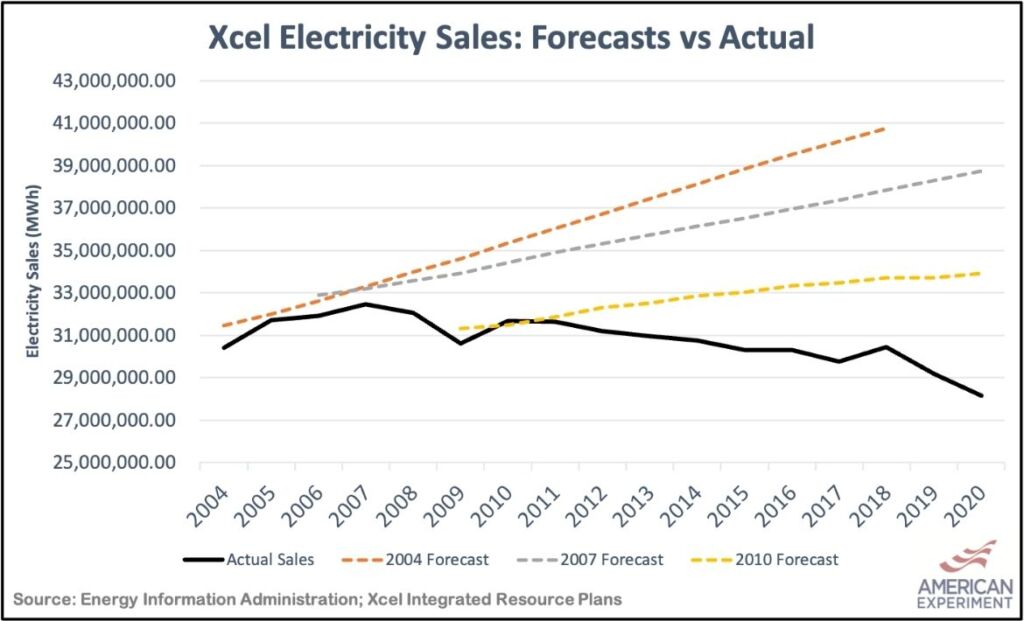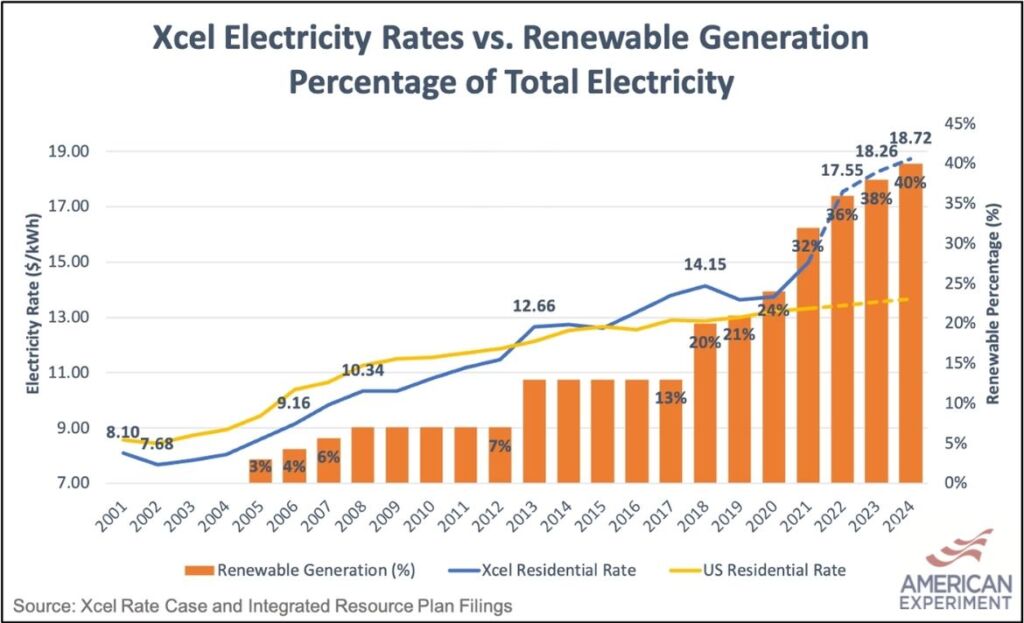Xcel Energy claimed electricity rates would remain “well below” national average in 2010: Three years later they were neck-and-neck
Xcel Energy, Minnesota’s largest electric utility company, claimed in 2010 that it expected electricity prices for customers to remain “well below” the national average through 2025.
Xcel made this prediction to the Minnesota Public Utilities Commission (PUC) in its 2011-2025 Integrated Resource Plan (IRP), stating “we fully expect to maintain an average retail price that is well below the national average.” At the time, Xcel was seeking approval to invest billions of dollars building new wind turbines, solar panels, and transmission lines at the expense of ratepayers to comply with Minnesota’s renewable energy mandate.
This prediction was wildly incorrect.
At the time (in 2010), Xcel had electricity rates that were 14 percent lower than the national average. It was only three years later, in 2013, that Xcel’s average price of electricity fell to less than 1 percent below the national average, while finally surpassing it entirely in 2017, as you can see in the graph below.

How did the cost of electricity at Xcel become so expensive, so quickly?
It’s a combination of factors.
First, large investments in wind turbines and solar panels were made to satisfy Minnesota’s renewable energy mandate. These investments totaled in the billions of dollars and increased the amount of money Xcel needed to recover from ratepayers — which is called the “revenue requirement” and determined by the Minnesota PUC.
Additionally, as a government-regulated monopoly, this revenue requirement includes a 9.2 percent profit on the infrastructure it builds. In other words, Xcel was allowed to charge customers 9.2 percent interest on the renewable energy additions it has made since the passage of Minnesota’s renewable energy mandate.
In this way, Minnesota’s renewable energy mandate handed Xcel a blank check.
Second, the renewable energy mandate not only increased the amount of money Xcel was spending, thus increasing the amount it needed to recover from ratepayers, it also changed the way Xcel spent money by replacing variable costs with fixed costs.
Utility companies generally have two kinds of costs — fixed costs and variable. Fixed costs are expenses that are incurred regardless of how much electricity a power plant produces, such as construction costs, financing costs, and insurance. Variable costs are expenses that go up and down based on how much electricity is generated, the most common of which is fuel cost.
Complying with Minnesota’s renewable energy mandate made Xcel less reliant on fuel costs, thus reducing Xcel’s variable expenses, and replaced these expenses with large amounts of fixed costs to pay for the construction of wind turbines, solar panels, and transmission lines.
Because fixed expenses remain the same no matter how much electricity, the renewable energy mandate effectively locked in higher spending for years to come, even if families and businesses used less electricity. This is contrary to fuel expenses, that decrease as electricity usage declines.
This leads us to the third reason the cost of electricity at Xcel failed to keep electricity rates “well below” the national average, as it said it would in 2010.
On top of increasing spending, Xcel vastly over-forecasted future electricity usage in every IRP since at least 2007, as the graph below shows.

As a result, Xcel significantly overbuilt its electricity grid over the years because it continued to invest heavily in renewable energy sources despite declining sales.
Most people understand that forecasts are imperfect. However, the decision by the PUC and Xcel not to adjust the utility company’s level of spending when confronted with unexpectedly low sales has had a devastating effect on the cost of electricity for Xcel customers.
Electricity prices are established using basic math. The Minnesota PUC determines the revenue requirement that utilities can recover from ratepayers, and this value is divided by total electricity sales. [Total cost / total sales = price].
Revenue Requirement (Dollars) /
Units of Electricity Sold (Megawatt Hours)
As you can see, if the revenue requirement (top) continues to grow while the number of sales (bottom) decreases, this necessarily results in higher electricity prices.
And, according to Xcel, it never had to be this way.
Minnesota PUC commissioners had the power to step in and delay compliance with Minnesota’s renewable energy mandate if it proved to be too expensive. Xcel noted this fact in its IRP filed in 2007, immediately after the renewable energy standard (RES) was passed, stating:
The [PUC] Commission may modify or delay the RES… if it finds that compliance would cause significant rate impacts, require significant measures to address reliability, or raise significant technical issues. [Emphasis added]
Additionally, Xcel made known that it, too, would monitor the cost of electricity during RES compliance to make sure electricity costs remained “reasonable”:
The RES sets an aggressive goal that we are committed to achieving. That said, it is only prudent that we recognize the possibility that we will be unable to implement all of the wind energy needed to fulfill our RES requirements, or that the economics will change and the costs of compliance would no longer be reasonable. The RES provides that we continue to monitor the costs and progress through implementation through each Resource Plan…
According to Xcel in 2010, the benchmark for reasonable costs was maintaining electricity rates “well below” the national average. That was the expectation, and Xcel shattered it within 3 years.
Xcel’s residential, commercial, and industrial rates were once 12 percent, 28 percent, and 18 percent lower than the national average, respectively. Today, after requesting eight increases on electricity customers since the passage of Minnesota’s renewable energy mandate, every rate class at Xcel is above or matching the national average and set to increase even further.
If there was any sign that costs were “no longer reasonable,” or that compliance in the renewable energy mandate was causing “significant rate impacts,” it was Xcel surpassing the national average in electricity prices when it “fully” expected to remain “well below.”
Despite this dramatic increase in the cost of electricity, however, neither Xcel nor PUC commissioner sounded the alarm.
Instead, Xcel ratepayers have been stuck paying off billions of dollars in fixed expenses to pay for enormous renewable energy investments made in prior years. This is why Xcel’s average electricity rate increased more than 3.7 times faster than the national average over the last decade.
If Xcel’s latest 21.2 percent rate increase request is approved, which Xcel states is to pay for the cost of building wind turbines and solar panels in its rate case filing, residential electricity rates at Xcel are set to become up to 40 percent higher than the national average, as the graph below shows, if the national average continues 5-year historical trends.

And if that’s not enough, the PUC is still allowing Xcel to raise electricity prices on customers to continue spending billions on renewable energy additions, despite Xcel already satisfying Minnesota’s renewable energy mandate.
Minnesota PUC commissioners are still working through Xcel’s 2020-2034 resource plan. American Experiment’s cost modeling concluded that this plan, if approved, would raise the cost of electricity by $1,200 annually per Xcel customer through 2050 by investing billions of dollars in new wind turbines and solar panels that are no longer needed to satisfy Minnesota’s renewable energy mandate. The only purpose behind Xcel’s new plan — and the resulting increase in the cost of electricity — is to achieve an internal company goal of reaching 100 percent carbon-free energy by 2050.